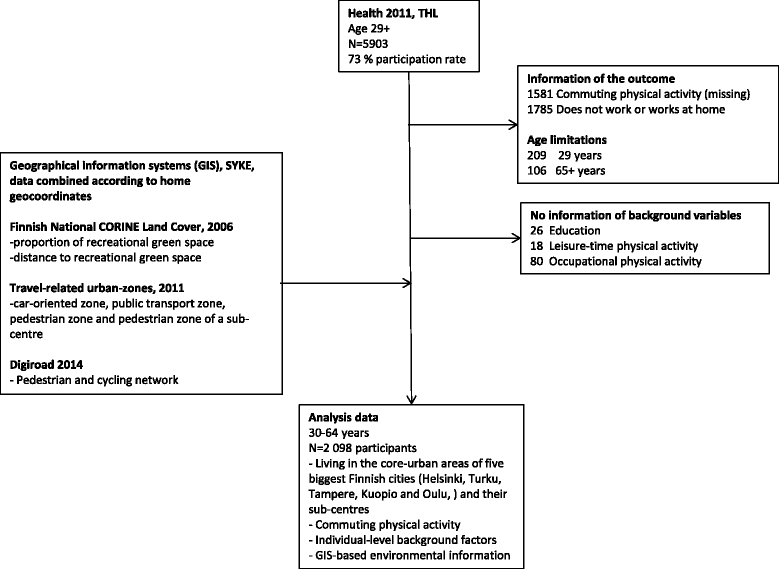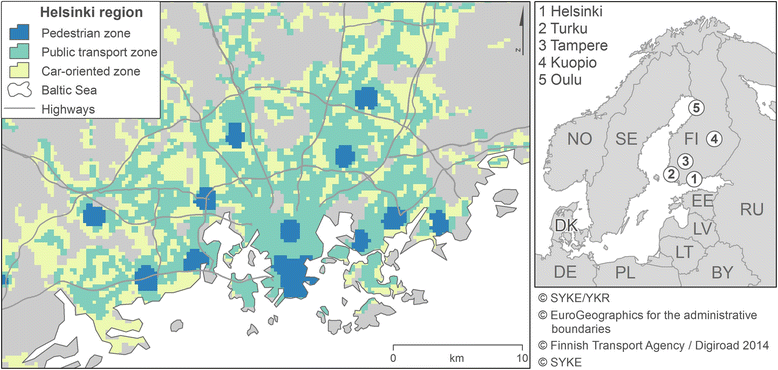The contribution of travel-related urban zones, cycling and pedestrian networks and green space to commuting physical activity among adults - a cross-sectional population-based study using geographical information systems
- PMID: 27516181
- PMCID: PMC4982435
- DOI: 10.1186/s12889-016-3264-x
The contribution of travel-related urban zones, cycling and pedestrian networks and green space to commuting physical activity among adults - a cross-sectional population-based study using geographical information systems
Abstract
Background: The current political agenda aims to promote active environments and physical activity while commuting to work, but research on it has provided mixed results. This study examines whether the proximity of green space and people's residence in different travel-related urban zones contributes to commuting physical activity.
Methods: Population-based cross-sectional health examination survey, Health 2011 study, and geographical information system (GIS) data were utilized. The GIS data on green space and travel-related urban zones were linked to the individuals of the Health 2011 study, based on their home geocoordinates. Commuting physical activity was self-reported. Logistic regression models were applied, and age, gender, education, leisure-time and occupational physical activity were adjusted. Analyses were limited to those of working age, living in the core-urban areas of Finland and having completed information on commuting physical activity (n = 2 098).
Results: Home location in a pedestrian zone of a main centre (odds ratio = 1.63; 95 % confidence interval = 1.06-2.51) or a pedestrian zone of a sub-centre (2.03; 1.09-3.80) and higher proportion of cycling and pedestrian networks (3.28; 1.71-6.31) contributed to higher levels of commuting physical activity. The contribution remained after adjusting for all the environmental attributes and individuals. Based on interaction analyses, women living in a public transport zone were almost two times more likely to be physically active while commuting compared to men. A high proportion of recreational green space contributed negatively to the levels of commuting physical activity (0.73; 0.57-0.94) after adjusting for several background factors. Based on interaction analyses, individuals aged from 44 to 54 years and living in sub-centres, men living in pedestrian zones of sub-centres, and those individuals who are physically inactive during leisure-time were less likely to be physically active while commuting.
Conclusions: Good pedestrian and cycling infrastructure may play an important role in promoting commuting physical activity among the employed population, regardless of educational background, leisure-time and occupational physical activity. Close proximity to green space and a high proportion of green space near the home may not be sufficient to initiate commuting physical activity in Finland, where homes surrounded by green areas are often situated in car-oriented zones far from work places.
Keywords: Built environment; Finland; GIS; Green space; Population study; Socioecological model; Transport-related physical activity.
Figures


Similar articles
-
Walking and cycling for commuting, leisure and errands: relations with individual characteristics and leisure-time physical activity in a cross-sectional survey (the ACTI-Cités project).Int J Behav Nutr Phys Act. 2015 Dec 9;12:150. doi: 10.1186/s12966-015-0310-5. Int J Behav Nutr Phys Act. 2015. PMID: 26646510 Free PMC article.
-
Longitudinal effects of urban green space on walking and cycling: A fixed effects analysis.Health Place. 2020 Jan;61:102264. doi: 10.1016/j.healthplace.2019.102264. Epub 2019 Dec 9. Health Place. 2020. PMID: 32329730
-
Longitudinal associations between built environment characteristics and changes in active commuting.BMC Public Health. 2017 May 17;17(1):458. doi: 10.1186/s12889-017-4396-3. BMC Public Health. 2017. PMID: 28693547 Free PMC article.
-
The impact of street greenery on active travel: a narrative systematic review.Front Public Health. 2024 Feb 28;12:1337804. doi: 10.3389/fpubh.2024.1337804. eCollection 2024. Front Public Health. 2024. PMID: 38481839 Free PMC article.
-
Health impacts of the Cambridgeshire Guided Busway: a natural experimental study.Southampton (UK): NIHR Journals Library; 2016 Jan. Southampton (UK): NIHR Journals Library; 2016 Jan. PMID: 26764445 Free Books & Documents. Review.
Cited by
-
Virtual Reality Representations of Nature to Improve Well-Being amongst Older Adults: a Rapid Review.J Technol Behav Sci. 2021;6(3):464-485. doi: 10.1007/s41347-021-00195-6. Epub 2021 Mar 5. J Technol Behav Sci. 2021. PMID: 33688575 Free PMC article. Review.
-
Translating Urban Walkability Initiatives for Older Adults in Rural and Under-Resourced Communities.Int J Environ Res Public Health. 2019 Aug 22;16(17):3041. doi: 10.3390/ijerph16173041. Int J Environ Res Public Health. 2019. PMID: 31443359 Free PMC article. Review.
-
The effects of green space and physical activity on muscle strength: a national cross-sectional survey with 128,759 Chinese adults.Front Public Health. 2023 May 17;11:973158. doi: 10.3389/fpubh.2023.973158. eCollection 2023. Front Public Health. 2023. PMID: 37265516 Free PMC article.
-
Area-level and individual correlates of active transportation among adults in Germany: A population-based multilevel study.Sci Rep. 2019 Nov 8;9(1):16361. doi: 10.1038/s41598-019-52888-x. Sci Rep. 2019. PMID: 31705025 Free PMC article.
-
Physical Activity Habits of Latvian Nursing Students: A Cross-Sectional Study.Nurs Rep. 2022 Nov 30;12(4):922-932. doi: 10.3390/nursrep12040089. Nurs Rep. 2022. PMID: 36548162 Free PMC article.
References
-
- WHO. Physical activity promotion in socially disadvatanged groups: principles for action. PHAN Work Package 4. Final report. 2013. http://www.euro.who.int/en/health-topics/environment-and-health/Transpor.... Accessed 24 Apr 2016.
-
- Bouchard C, Blair SN, Haskell WL. Why Study Physical Activity and Health? In: Bouchard C, Blair SN, Haskell WL, editors. Physical Activity and Health. Stanningley: Human Kinetics Inc.; 2006. pp. 3–19.
-
- Caspersen CJ. Physical activity epidemiology: concepts, methods, and applications to exercise science. Exerc Sport Sci Rev. 1989;17:423–73. - PubMed
MeSH terms
LinkOut - more resources
Full Text Sources
Other Literature Sources
Medical

